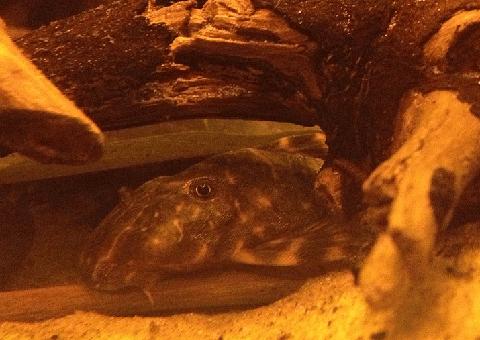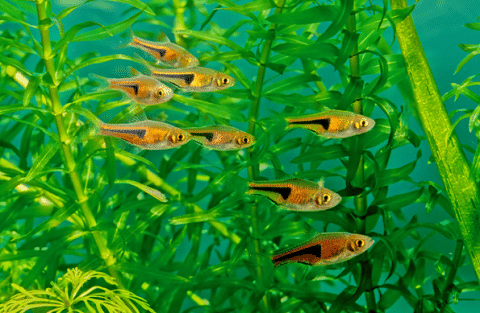Thank you for visiting! By the way… any links on this page that lead to products on Amazon and other stores/partners are affiliate links Aquarium Store Depot earns a commission if you make a purchase.
Have you ever seen a fish that is bright and one-of-a-kind but also helps keep your tank clean by consuming algae? Meet the clown pleco! Native to South America, these attractive little creatures have earned their spot in any freshwater aquarium for their impressive ability to devour algae. This detailed care guide will supply all the necessary information on how to look after the Clown Pleco from its origin through compatible tank mates, breeding, diet requirements and health issues so it thrives in your home aquarium.
Dive into uncovering more about clown plecos, an easy, small Pleco with remarkable skills at eating up algae! We’ll learn about where they come from originally as well as details like size parameters, lifespan and appearance – so we can get familiarized better with these enthralling animals.
Key Takeaways
- Clown pleco are great beginner fish for home aquariums, requiring dim or indirect light and natural decor to replicate their native environment.
- With the right care, clown plecos can have a long and healthy life in your tank with compatible tank mates like other calm species.
- Regular maintenance is important to prevent common health issues such as illness and ensure they stay happy & healthy!
Species Overview
| Scientific Name | Panaque maccus |
| Common Names | Clown Pleco, Clown Panaque, Ringlet Pleco, Striped Clown Pleco, Clown Panaque |
| Family | Loricariidae |
| Origin | Venezuela, South America |
| Diet | Omnivorous |
| Care Difficulty | Easy |
| Activity | Active |
| Life Expectancy | 10 – 12 years |
| Temperament | Peaceful |
| Tank Level | Bottom Dweller |
| Minimum Tank Size | 20 gallons (75 liters) |
| Temperature Range | 73-82°F (23-28°C) |
| Water Hardness | 5-10 dKH (degrees of Carbonate Hardness) |
| pH Range | 6.8 to 7.6 |
| Filtration/Water Flow | Moderate to high |
| Water Type | Freshwater |
| Breeding | Egg layer |
| Difficulty to Breed | Moderate |
| Compatibility | Community Tanks |
| OK, for Planted Tanks? | Yes |
Introduction
Panaqolus maccus, commonly known as the clown pleco, are a type of small freshwater fish native to South America’s swift-flowing rivers. With their attractive colors and patterns, they have become popular inhabitants in home aquariums. These peaceful creatures enjoy swimming around the fish tank while scouring for food – also fulfilling an important role as an algae eater which keeps your freshwater fish tank tidy and healthy!
Their low upkeep demands make them ideal for rookie aquarists who wish to keep more than one kind of species together within the same environment without having difficulties. If you opt for these lovely little guys, be sure that all other potential tank mates will get along with no problems or hassles.
Origin And Habitants
Wild Clown plecos, otherwise known as ringlet plecos, can be found in the rivers of Venezuela and Colombia. These fish thrive under fast flowing waters with dense root systems along with a forest nearby which provides them algae-covered rocks and driftwood to feed on vegetation that grows here. To ensure they are healthy, it’s key we create an environment resembling its natural habitat while maintaining correct water parameters.
Appearance

The Clown pleco boast captivating patterns in circles, stripes and waves that contrast against their flat heads tapering down to a tail. They are often labelled “mega clown plecos” when growing larger than usual due to this impressive display of coloration coupled with evenly sized pectoral fins. Such traits make them highly desirable among aquarists looking for some characterful additions into the home aquarium setup.
At night, the Clown Pleco really comes alive. Being nocturnal creatures, they appreciate dim or indirect lighting around them during the day as bright light has an adverse effect on their behavior, forcing them into hiding among rocks and wood pieces near dark areas where they feel safe from harm’s way.
Size
The Clown pleco is an excellent choice for those looking to keep fish in a small tank. Clown Pleco Size as adults can be up to 5 inches long, but will usually stay at around 3-4 inches. Just make sure the water quality is healthy! Poor conditions could harm their health or reduce growth size, so taking care of your aquarium environment must be taken seriously when it comes to these pets. With good maintenance on our part, we can all look forward to having such captivating inhabitants flourish happily in our homes’ tanks!
Lifespan And Growth
The Clown Pleco has the potential to live up to 10-12 years if given the necessary living requirements, attention, and nutritional balance. Tankmates that are too aggressive or poor water quality can decrease their lifespan significantly. It is important for fish keepers to make sure they create an appropriate environment with cleanliness in mind as well as protect your pet from any form of distress so you can delight in its presence over many enjoyable years.
Clown Pleco Care Guide – The Essential
Clown pleco care is a relatively straightforward task, ideal for beginner aquarists. These fish will do best in an aquarium with ample space and appropriate filtration that mimics their natural environment. Supplying them with the right home will ensure they remain content and healthy.
We’ll look at all of the key components necessary when caring for clown plecos – from tank setup to water parameters, aeration, and beyond, so you can provide your pet with just what it needs!
Tank Setup And Environment
For a single clown pleco, it is best to have at least 20 gallons of tank space for the Clown pleco to have room to swim around. Community setups should include no less than 40 gallons so all species can thrive peacefully. When setting up your aquarium, be sure to add natural elements such as driftwood pieces and caves with softer substrates like sand or fine gravel alongside rocks, which encourage edible algae growth. These features make the environment stimulating and secure for any Clown Plecos within their territorial boundaries.
The Clown Pleco is a driftwood eater. It is best to have a good source available. Spiderwood is going to be the softest and least lasting for them. Manzanita and Malaysian driftwood are better choices long term. Aquarium rocks are also good to have so algae and grow on them for additional food sources.
Editor's Choice
Manzanita offers it all. Great shape, low tannins, quick to water log and reasonably priced. It's the ultimate driftwood!
Water Parameters
It is important for the health of your clown pleco to keep water parameters at their optimal levels. The temperature should be between 73-83°F, with a pH ranging from 6.8 and 7.6 and a hardness no higher than 10 dGH. Regular aquarium changes are necessary in order to avoid accumulating any harmful toxins within its environment. Here are other key parameters to look out for:
Filtration And Aeration
Maintaining a healthy environment for your clown pleco is key to their well being and long-term survival. An optimal setup includes the use of either a canister or HOB filter with replaceable filters, as well as an air stone which will help oxygenate the water. To create a moderate flow rate along the bottom of the tank, similar to what they would experience out in nature. Having these components combined correctly ensures that your clown pleco receives clean, oxygenated water so it can remain safe and happy!
The Pro's Choice
The top choice among professional aquascapers. German engineering and equipped with an intregrated heater.
Feeding Your Clown Pleco
A proper Clown Pleco diet requires a variety of greens and insect matter. Consider feeding them other plant matter like zucchini or spinach (blanched for easier consumption) as well as high-quality sinking algae wafers. Offer occasional protein sources such as brine shrimp or bloodworms too.
Algae wafers are a great way to directly feed your bottom feeding fish. They are especially effective for larger fish like plecos
Having an abundance of driftwood and rocks will allow your Clown Pleco to eat algae that grow on the driftwood and rocks.
In order for your little fishy friend to stay healthy and grow properly, you should monitor what you are giving him from time to time in case any adjustments may be necessary. After all, having an appropriate balance of elements is very vital in maintaining his overall well being!
Compatible Tank Mates

When it comes to clown pleco tank mates, they are usually quite docile and can be kept together with other non-confrontational fish breeds in a community tank. One should stay away from dominant or belligerent species since their behavior might upset the well-being of your Clown Pleco, leading to reduced life expectancy.
With that being said, let’s go over a few compatible species for your Clown Pleco:
Because of the peaceful nature of your Clown Pleco. They can be housed with just about anyone as long as they can’t fit the fish in their mouths, and those fish can fit in theirs.
Tank Mates To Avoid
When considering what other species to add to your pleco’s community tank, it is important to avoid larger or more aggressive fishes that may put the clown pleco in harm’s way. As well as being aware of any competition for food and living space. These can lead to an unpleasant atmosphere if another fish outcompetes them.
Your Clown Pleco will not fight back (except against other bottom of the tank feeders). Knowing this, let’s list several species that are a clear no for them:
- Large aggressive fish that can mouth them in their mouths
- Larger fin nippers like Tiger Barb – larger pleco species are more appropriate
- Other plecos – they will fight
- Same Pleco species when both are male with inadequate space
By carefully researching which inhabitants would be suitable companions, you will ensure a comfortable habitat where they are able to flourish happily with their tank mates around them.
Territory And Space Considerations
It’s essential to ensure your Clown Pleco have enough room in order for them to be able to maintain their territories and live peacefully alongside other tank dwellers. A minimum of 20 gallons should be allotted for a community tank, avoiding confrontations between the aquatic inhabitants. Aquarium lights should either be dimmed, or you should have sections of the tank with shadows, as the Clown Pleco prefers lower light.
Tannins can also be introduced via Indian almond leaves or with driftwood that leaches them.
These leaves can be added to your aquarium to help promote a natural habitat for bettas, shrimp, and other soft-water loving fish. Betta breeders can use these leaves to help encourage breeding behavior.
In this way, a peaceful habitat can be maintained as aggression or unease among your Clown Pleco is less likely when there is sufficient space provided.
Breeding Clown Plecos
For those aquarists looking for a fulfilling experience, breeding a Clown Pleco offers the chance to witness and cultivate their fascinating reproductive behavior.
You must create proper parameters – ideal water quality with appropriate temperature range being key indicators that will determine the overall success rate amongst your population’s potential mating.
Male And Female Differences
Sexing your dwarf pleco can be tricky with a young clown pleco, but the signs are more obvious as they get older.
I’m going to share a photo from Planetcatfish that shows the visual differences between male clown plecos and female Clown Plecos. The main difference is there is a large genital papilla for the female that is visible on the side and ventral view.

If viewed from above, female clown plecos typically possess a wider body than their male counterparts, who may be slightly smaller in size with an overall less triangular head structure. Knowing these differences is essential for the successful breeding and mating of your Clown Plecostomus.
Preparing For Breeding
Clown Pleco breeding is best in a separate breeding tank set up with driftwood and an adequate cave for the fish to spawn in. The natural habitat of the Clown Pleco can then be replicated by slowly lowering water temperature and elevating pH levels during the mating process. Adding live foods such as bloodworms, brine shrimp or daphnia may also help trigger spawning. By setting up their ideal environment correctly, you will have higher chances of observing this interesting event while taking care of your clown plecos!
The female Clown Pleco produces large eggs and only drops 20-25 eggs. It takes 1-2 days for the female to completely lay her eggs and the male will watch the eggs. The eggs hatch after around 5 days, and it will take 25 days after hatching for the baby Clown Plecos to venture out of its original hatching spot.
Raising Fry
The delight of watching clown plecos develop can be achieved by providing attentive care throughout the fry’s life. For their optimal growth, you must maintain consistent water parameters and ensure they are fed algae as well as driftwood. Overcrowding should be avoided to prevent stress among your fish population since it causes a battle for resources.
Common Health Issues And Prevention
Good water quality and a clean tank are key to keeping your clown plecos healthy. Regularly changing the tank’s water, having proper filtration equipment in place, as well as providing them with adequate nutrition will help prevent any potential diseases from occurring.
Should you spot any white spots on their bodies that may be symptomatic of Ich – an infectious parasite – then immediate treatment is necessary for prevention purposes. Remove all charcoal filters from the aquarium and replace one third of its contents with freshly treated water before leaving it undisturbed for 24 hours.
Repeat until there’s no longer evidence of the disease remaining. This process must be carried out swiftly to ensure full recovery and prolonged life expectancy if, indeed, Ich has been contracted by your clown pleco fish.
Frequently Asked Questions
How big do clown plecos get?
The Clown Pleco belong to the Loricariid family, also labeled as L104, 162 or LDA22. They are an excellent choice for smaller tanks since they typically measure 3-4 inches in size and require only little attention from owners. These fish can contribute by consuming algae that builds up within aquariums.
How big of a tank does a clown pleco need?
For keeping a Clown Pleco, you should opt for a tank of at least 20 gallons. These fish don’t need vast amounts of space to be content, meaning investing in an expansive aquarium isn’t necessary, even small tanks can provide them with a comfortable home.
Do clown plecos need wood?
Experts recommend that clown plecos should have access to wood in their tank for the best nutrition. They usually feed on algae from glass and rocks, but it’s been noticed that they gain most of their nutrients by consuming the outer layer of decaying driftwood. Providing aquarium safe cholla wood is strongly suggested so these fish can benefit optimally.
Can you keep 2 clown plecos together?
When keeping two clown plecos together, it is necessary to have a large aquarium with plenty of hiding spaces for them. It also must be ensured that the tank contains adequate food supplies so they don’t compete for resources and both get an equal share. Close observation should take place regularly in order to verify if these fish are peacefully co-habitating or not.
How big will a clown pleco get?
A Clown Pleco are a suitable starter pet for any aquarium hobbyist due to their low upkeep needs, even though they can grow up to 4 inches in length. Typically, this fish species reaches an average size of around 3 and half inches.
Given that these little creatures don’t require much from their owners other than occasional maintenance tasks such as cleaning the tank or changing water levels, clown plecos make great pets!
Closing Thoughts
Taking care of clown plecos can be a fulfilling experience when you know their distinct characteristics and create the right environment for them to thrive in, similar to their natural habitat. Appropriate nutrition with compatible tank mates and keeping an eye on potential health concerns are necessary steps in making sure they live a long life that brings joy through their beauty, coloration, and algae-eating capabilities.
- About the Author
- Latest Posts
I’m thrilled that you found Aquarium Store Depot! Here you’ll find information on fish, aquariums, and all things aquatics related. I’m a hobbyist (being doing this since I was 11) and here to help other hobbyists thrive with their aquariums! I adhere to a high quality Editorial Process and Review products with real life field usage and practical analysis.









